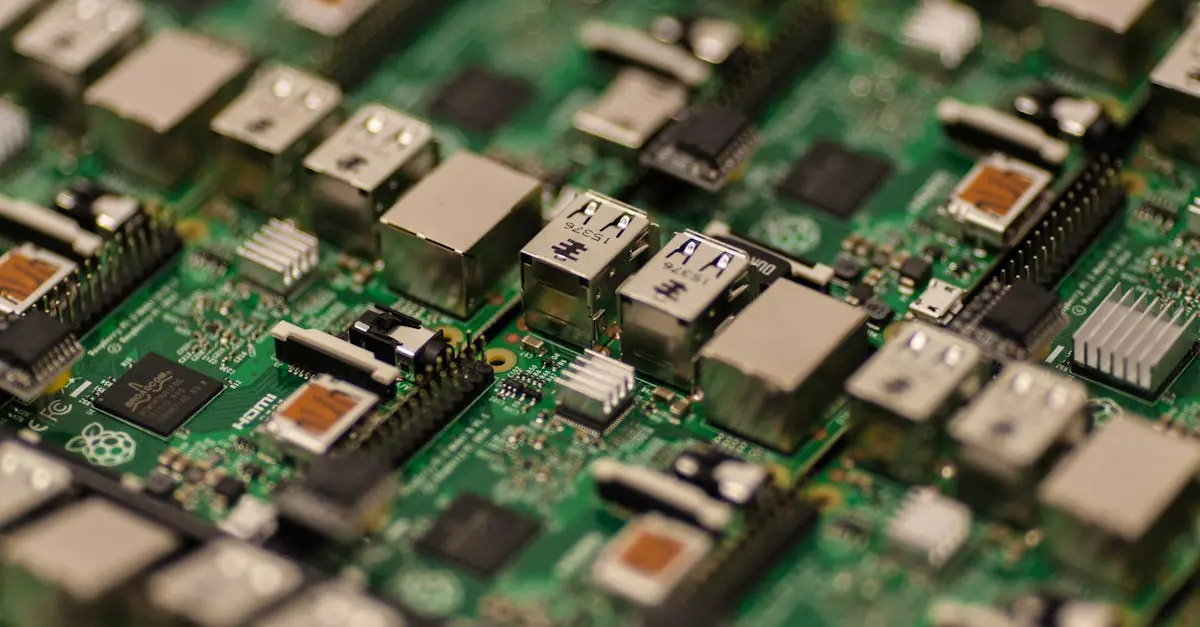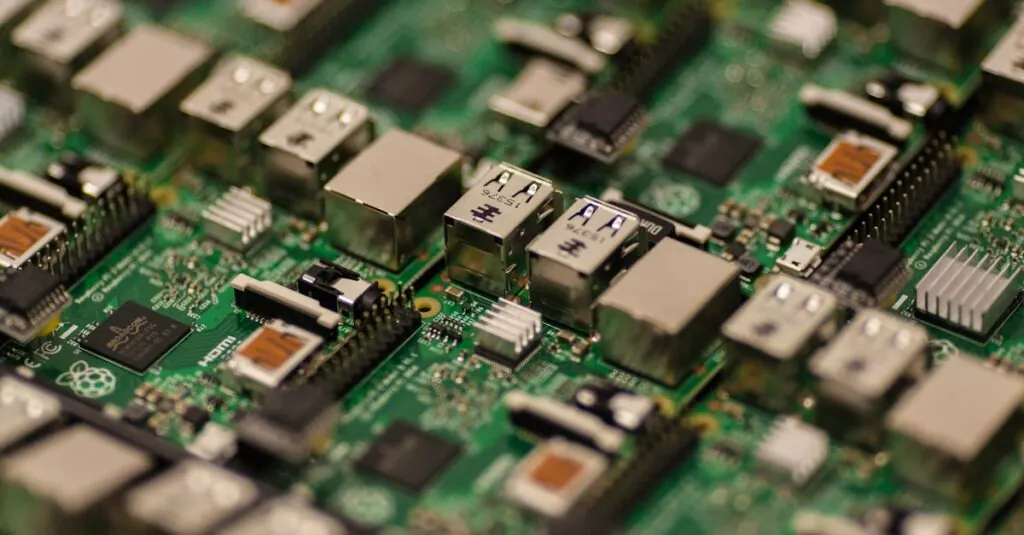Table of Contents
ToggleIn a world where everything seems to be getting smarter, embedded hardware systems are the unsung heroes working tirelessly behind the scenes. These tiny powerhouses quietly control everything from your microwave to your car, ensuring that life runs smoothly—like butter on a hot pancake. If you think about it, they’re like the ninjas of technology: stealthy, efficient, and crucial to modern life.
Overview of Embedded Hardware Systems
Embedded hardware systems comprise specialized computer systems designed to perform dedicated functions within larger mechanical or electrical systems. These systems integrate both hardware and software to achieve specific tasks in devices where efficiency and reliability are critical. Characteristics such as compactness, energy efficiency, and real-time performance define their operation.
Numerous applications utilize embedded hardware systems. Consumer electronics like smartphones and smart appliances rely on these systems for seamless user experiences. Automotive applications incorporate embedded systems for engine control, navigation, and safety features. Additionally, industrial automation employs embedded systems for process control and monitoring.
Various components constitute embedded hardware systems. Microcontrollers serve as the brain, processing data and controlling hardware actions. Sensors gather environmental data, while actuators perform physical actions in response to control signals. Memory components store essential data and program code, ensuring operational efficiency.
The design process for embedded hardware systems requires careful consideration. Engineers must prioritize factors such as power consumption, processing power, and size to meet specific project requirements. Close collaboration between hardware and software teams plays a significant role in successful system design.
Embedded hardware systems represent crucial elements that enhance functionality across various applications. Their silent yet impactful roles support modern life, proving essential in diverse sectors like telecommunications, automotive, and healthcare. By integrating advanced technology, these systems contribute significantly to innovation and efficiency in today’s devices.
Key Components of Embedded Hardware Systems
Embedded hardware systems consist of several crucial components that function together to achieve specific tasks. Understanding these components reveals how embedded systems operate effectively.
Microcontrollers
Microcontrollers serve as the brain of embedded hardware systems. These compact computing devices execute instructions, control hardware operations, and manage processes. Typically, a microcontroller integrates a processor, memory, and input/output peripherals on a single chip. They can be found in various applications, from household appliances to automotive systems. Programmability is a key feature of microcontrollers, enabling developers to tailor functionalities based on project requirements.
Sensors and Actuators
Sensors and actuators work hand-in-hand to facilitate interaction with the physical environment. Sensors detect changes in conditions like temperature or motion, converting real-world data into electronic signals. In contrast, actuators respond to those signals by performing physical actions, such as opening a valve or moving a motor. Together, these components enable systems to react dynamically. Examples can be found in smart home devices that adjust heating based on temperature readings, showcasing their importance in automation.
Communication Interfaces
Communication interfaces enable embedded hardware systems to connect and exchange data. Various protocols are employed to facilitate communication, including UART, I2C, and SPI. These interfaces allow devices to communicate both locally and over networks. The inclusion of wireless communication standards like Wi-Fi and Bluetooth further expands connectivity options. Overall, robust communication interfaces enhance system integration and enable seamless data exchange between devices, which is essential for networked applications.
Applications of Embedded Hardware Systems
Embedded hardware systems play crucial roles across various sectors, ensuring efficiency and reliability in their applications. Key industries include automotive, medical devices, and consumer electronics.
Automotive Industry
Automotive applications utilize embedded hardware systems for multiple functions. Advanced Driver Assistance Systems (ADAS) rely on sensors and microcontrollers to enhance safety features. For example, adaptive cruise control and lane-keeping assist require real-time data processing. Engine control units manage performance and emissions, ensuring compliance with environmental regulations. Furthermore, infotainment systems deliver entertainment and navigation, integrating connectivity for enhanced user experience. Overall, embedded systems significantly contribute to vehicle performance, safety, and driver convenience.
Medical Devices
Medical devices depend on embedded hardware systems to improve patient care and diagnostics. Devices like glucose monitors and pacemakers utilize microcontrollers to process critical data. Real-time monitoring of patient vitals ensures accurate and timely interventions. Moreover, imaging equipment like MRI machines rely on embedded systems for data acquisition and analysis. These systems allow healthcare professionals to make informed decisions. Regulatory compliance drives the need for reliability and precision, making embedded systems essential in modern healthcare devices.
Consumer Electronics
Consumer electronics represent a prominent domain for embedded hardware systems. Smart home devices, including thermostats and security systems, rely on microcontrollers for automation and remote access. User interfaces developed through embedded systems enhance usability and interaction. Televisions, smartphones, and wearables utilize these systems for performance optimization, facilitating seamless experiences. IoT integration showcases how embedded systems enable data sharing between devices, increasing functionality. Collectively, these applications highlight the versatility and necessity of embedded hardware in everyday life.
Challenges in Embedded Hardware Systems
Embedded hardware systems face several challenges that impact their design and functionality. These challenges require a deep understanding of both hardware and software components.
Design Complexity
Design complexity poses significant challenges for embedded systems. Multiple factors contribute to intricate designs, including power optimization and space constraints. Engineers must balance processing power, memory capacity, and energy consumption to meet performance requirements. This balancing act often leads to extended development cycles and increased costs. Integrating various components such as microcontrollers, sensors, and communication interfaces adds layers of difficulty. Collaboration between hardware and software teams becomes essential for optimizing performance while adhering to strict deadlines.
Security Concerns
Security concerns present another crucial challenge for embedded hardware systems. As these systems connect to networks, vulnerabilities arise. Attackers may exploit weaknesses, compromising sensitive data and device functionality. Implementing robust security measures, such as encryption and secure boot processes, becomes necessary to protect against threats. Additionally, regular updates and patches are critical for maintaining security throughout a system’s lifecycle. The potential consequences of security breaches can result in significant financial losses and reputational damage, making security a top priority in embedded systems development.
Future Trends in Embedded Hardware Systems
Advancements in embedded hardware systems are poised to transform multiple industries significantly. The integration of artificial intelligence enhances decision-making, enabling systems to learn from data and improve over time. Increased miniaturization of components leads to more compact designs, allowing for the creation of even smaller devices.
Internet of Things (IoT) connectivity continues to expand, making embedded systems smarter and more interconnected. This trend enhances data sharing and analysis, enabling real-time monitoring of devices in various applications. Moreover, the adoption of edge computing reduces latency by processing data closer to the source, improving system responsiveness.
Energy efficiency remains a pivotal focus as developers seek sustainable solutions. Innovations in low-power components allow devices to operate for extended periods without frequent battery replacements. Sustainable practices in manufacturing further contribute to reducing the environmental impact of embedded systems.
Cybersecurity is increasingly prioritized as these systems face growing vulnerabilities. Enhanced security protocols such as advanced encryption and secure boot processes protect against cyber threats. Regular updates and patches also play a crucial role in maintaining system integrity.
Collaboration between hardware and software teams is essential for addressing these evolving challenges. Agile methodologies promote flexibility in the design process, enabling quicker adaptations to technological advancements. This collaboration ensures that embedded systems remain robust, efficient, and secure within their operating environments.
Regulatory compliance becomes essential as industries face stricter standards. Embedded systems must now adhere to guidelines, especially in healthcare and automotive sectors. Adapting to these regulations ensures the reliability and safety of products while fostering consumer trust.
Together, these trends signify a future where embedded hardware systems become more efficient, secure, and integral to everyday technology.
Conclusion
Embedded hardware systems are undeniably crucial in shaping modern technology. Their ability to operate seamlessly within various devices ensures efficiency and reliability across multiple sectors. As industries continue to evolve with advancements in artificial intelligence and IoT, these systems will play an even more significant role in enhancing functionality and connectivity.
The challenges they face, including design complexity and security concerns, highlight the need for ongoing innovation and collaboration among teams. With a focus on energy efficiency and robust security measures, the future of embedded hardware systems promises to be more integrated and sophisticated. Their impact on everyday life will only grow, reinforcing their status as the backbone of contemporary technology.




